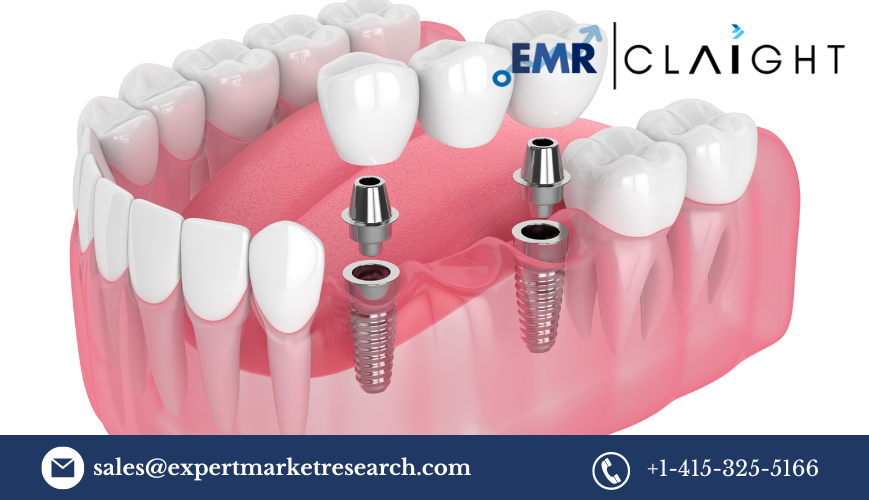The dental 3D printing market is on a remarkable growth trajectory, driven by the rising prevalence of dental disorders and technological advancements. In 2023, the market was valued at USD 2.48 billion, and it is projected to grow at an impressive CAGR of 24.20% from 2024 to 2032, reaching a staggering USD 17.47 billion by 2032. In this blog, we will delve into the key factors driving this market, the major players involved, and what the future holds for dental 3D printing.
Rising Prevalence of Dental Disorders
One of the primary drivers of the dental 3D printing market is the increasing prevalence of dental disorders globally. Dental caries, periodontal diseases, and tooth loss are common issues affecting millions of people worldwide. As the global population ages, the incidence of these dental problems is expected to rise, leading to a higher demand for dental care and restorative procedures.
Dental 3D printing offers a solution by enabling the production of precise and customized dental products such as crowns, bridges, dentures, and implants. This technology allows for the creation of prosthetics that fit perfectly, improving patient comfort and outcomes. As a result, dental professionals are increasingly adopting 3D printing to enhance their treatment capabilities.
Technological Innovations
Technological advancements in 3D printing have revolutionized the dental industry. The integration of digital dentistry with 3D printing technology allows for the creation of highly accurate and customized dental products. Key innovations driving this market include:
Advanced 3D Printing Techniques
- Stereolithography (SLA): Uses a laser to cure liquid resin into solid parts, providing high precision and smooth surface finishes.
- Digital Light Processing (DLP): Similar to SLA but uses a digital light projector screen to flash a single image of each layer all at once, offering faster production times.
- Selective Laser Sintering (SLS): Uses a laser to sinter powdered material, creating strong and durable parts suitable for dental applications.
- Fused Deposition Modeling (FDM): Involves the extrusion of thermoplastic materials to build parts layer by layer, commonly used for prototyping and creating dental models.
Biocompatible Materials
The development of biocompatible materials has been crucial for dental 3D printing. These materials must be safe for use in the human body and capable of withstanding the oral environment. Innovations in resin and metal powders have led to the creation of dental products that are durable, aesthetically pleasing, and biocompatible.
Software Integration
Advanced software solutions enable the seamless integration of 3D printing with digital imaging technologies like intraoral scanners and CAD/CAM systems. This integration streamlines the workflow, from patient diagnosis and treatment planning to the fabrication of dental prosthetics, ensuring precision and efficiency.
Increasing Adoption in Dental Clinics and Laboratories
Dental clinics and laboratories are increasingly adopting 3D printing technology due to its efficiency and precision. The ability to produce dental products in-house reduces turnaround times and costs, providing a competitive edge. Key benefits include:
Efficiency and Precision
3D printing allows for the rapid production of dental models, surgical guides, and prosthetics with high accuracy. This precision leads to better-fitting dental appliances and improved patient outcomes.
Cost-Effectiveness
By bringing the manufacturing process in-house, dental clinics and laboratories can reduce reliance on external suppliers, lowering production costs. Additionally, the ability to produce customized products on-demand minimizes waste and inventory costs.
Key Players in the Market
Several key players dominate the global dental 3D printing market, each contributing to its growth through innovations and strategic initiatives. Notable companies include:
- 3D Systems, Inc.: A pioneer in 3D printing technology, offering a wide range of solutions for dental applications.
- Stratasys Ltd.: Known for its advanced 3D printing systems and materials, catering to the dental industry.
- Roland DGA Corporation: Provides high-precision 3D milling and printing solutions for dental applications.
- Dentsply Sirona: A leading manufacturer of dental equipment and technologies, including 3D printing solutions.
- Institut Straumann AG: Specializes in dental implants and prosthetics, leveraging 3D printing for customized solutions.
- Formlabs Inc.: Known for its user-friendly and high-precision 3D printers, widely used in dental practices.
- Prodways Tech: Offers a range of 3D printing solutions for dental laboratories and clinics.
These companies are actively involved in mergers, acquisitions, capacity expansions, and investments in research and development to stay ahead in the competitive landscape.
Market Segmentation
The dental 3D printing market can be segmented based on components, applications, and end-users:
By Component
- Equipment: 3D printers, scanners, milling machines.
- Materials: Resins, metals, polymers.
- Software and Services: CAD/CAM software, maintenance services.
By Application
- Prosthodontics: Crowns, bridges, dentures.
- Orthodontics: Aligners, retainers.
- Implantology: Dental implants, surgical guides.
By End-User
- Dental Laboratories: Production of dental models and prosthetics.
- Dental Clinics: On-site creation of customized dental products.
- Academic and Research Institutions: Research and development of new dental technologies and materials.
Regional Analysis
The market shows significant regional variation, with North America, Europe, Asia Pacific, Latin America, and the Middle East & Africa each presenting unique growth opportunities and challenges:
North America
- Market Size and Trends: Largest market share due to advanced healthcare infrastructure and high adoption rates.
- Key Players and Strategies: Presence of major market players, high R&D investments.
Europe
- Market Size and Trends: Significant growth driven by technological advancements and increasing dental disorders.
- Key Players and Strategies: Strong presence of dental 3D printing companies, supportive regulatory environment.
Asia Pacific
- Market Size and Trends: Rapid growth due to increasing healthcare investments and growing awareness.
- Key Players and Strategies: Expanding presence of global companies, rising local competition.
Latin America
- Market Size and Trends: Emerging market with substantial growth potential.
- Key Players and Strategies: Government initiatives and investments in healthcare infrastructure.
Middle East & Africa
- Market Size and Trends: Gradual growth driven by increasing healthcare awareness and investments.
- Key Players and Strategies: Expansion of global companies, local market development.
Future Market Outlook
Looking ahead, the dental 3D printing market is poised for continued growth and innovation. Emerging trends include:
Development of New Biocompatible Materials
- Enhanced patient outcomes with materials that mimic natural tooth properties.
- Increased focus on developing materials that are safer and more durable.
Advancements in Digital Dentistry
- Integration of AI and machine learning for improved diagnostics and treatment planning.
- Enhanced software capabilities for seamless workflow integration.
Increased Collaboration and Partnerships
- Industry-academic partnerships for research and innovation.
- Joint ventures and alliances to expand market reach and capabilities.












